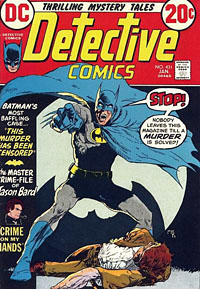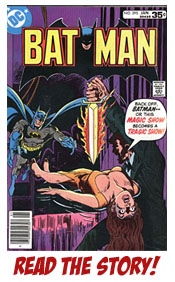|
Abandoning
50s-style adventures in time and space, 60s-style camp and
-- at least for a while -- colorful super-villains, the
Batman stories of the early Bronze Age put the emphasis
on mystery and sleuthing. The "Caped Crusader,"
we were reminded, is also "the World's Greatest Detective."
 Stories
of the 70s often found Batman conducting investigations
not from a Bat-Cave full of microscopes, computers and analyzers,
but on the streets of Gotham, using a handful of gadgets
from his utility belt, but more importantly his own keen
powers of observation and encyclopedic knowledge of crime
and science. Stories
of the 70s often found Batman conducting investigations
not from a Bat-Cave full of microscopes, computers and analyzers,
but on the streets of Gotham, using a handful of gadgets
from his utility belt, but more importantly his own keen
powers of observation and encyclopedic knowledge of crime
and science.
It may be hard to imagine these days, when
most Batman stories are concerned with large-scale carnage,
running battles and plots that focus myopically on Batman
and his closest allies, but there was a time when the character
did solve crimes. It wasn't uncommon for whole issues to
deal with unravelling the details of a mysterious death.
And not the death of a "major character" or sidekick,
but that of a common Gothamite, some poor schmuck in the
wrong place at the wrong time. In other words, Bronze Age
Batman had a job to do -- ridding Gotham of crime -- and
he did it. Not by lying in wait to beat the snot out of
small-time hoods, but by using his incomparable brain to
outfox even the craftiest murderer.
A sleuth in spandex was always an odd concept, which may
be why today's Batman favors Marvel-style butt-kickin' over
intellectual pursuits. But in the Bronze Age it helped set
him apart from the crowd. Batman was not only the hero we
could aspire to be, he was also the one who seemed really
concerned with what was happening in the real world. While
the rest of the longjohn crowd were battling world-eaters
and pummelling each other, somebody still had to work the
scene of a simple homicide. It was that focus on the real
world, on the human cost of crime, that gave the Batman
mythos its appeal. After all, Batman was the hero created
out of crime. He was a victim whose mission was to help
other victims.
Getting killed in Gotham left you as dead as getting killed
anywhere else. But at least you knew with Batman on the
job, the odds were better than good that your killer would
get caught.
THE HOUDINI WHODUNNIT
 Batman
#295 gave us this tale of old-fashioned sleuthing from
writer Gerry Conway and artist Michael Golden. This time
Batman has some help from the Mystery Analysts, a
group of professional and amateur detectives not seen since
the 60s and -- as far as I know -- never seen again after
this tale. Batman
#295 gave us this tale of old-fashioned sleuthing from
writer Gerry Conway and artist Michael Golden. This time
Batman has some help from the Mystery Analysts, a
group of professional and amateur detectives not seen since
the 60s and -- as far as I know -- never seen again after
this tale.
Golden was a good choice for Batman with his penchant for
lanky, lithe characters and his masterful use of blacks.
His work on the character here and elsewhere remains some
of my favorite stuff. As late as the 90s he provided memorable
covers for the bat-books and in 1984 he drew (most of) the
fondly remembered classic, "The
Player on the Other Side."
Besides the mystery angle, "Houdini" is also
memorable for Batman's display of prowess as an escape artist.
Sadly the printing processes used by DC in this period were
extremely poor, so my scans aren't fantastic, but the charm
of the story still comes through. So without further ado...Abra-Cadabra!
|



